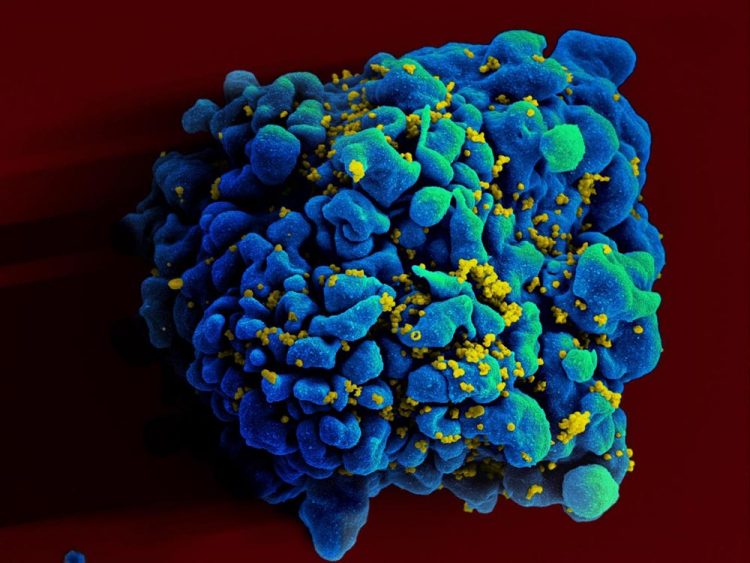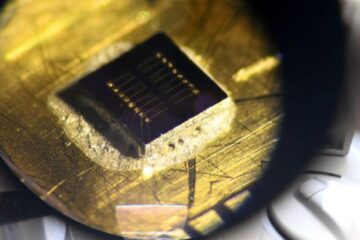NIH HIV experts prioritize research to achieve sustained ART-free HIV remission

Scanning electromicrograph of an HIV-infected T cell. Credit: NIAID
ART involves taking a combination (usually three) of drugs daily, often combined into a single pill. ART has transformed the lives of people with HIV, enabling those with access to the medications to live a near-normal lifespan. Despite this success, the side effects, pill fatigue, stigma and expense of taking daily ART for life have motivated researchers to find an alternative, write NIAID Director Anthony S. Fauci, M.D., and colleagues.
Consequently, scientists are seeking ways to put HIV into full and sustained remission so daily ART is unnecessary. The authors say feasible approaches must involve minimal risk and manageable side effects for people with HIV and must be inexpensive and scalable to millions of individuals.
A major obstacle to sustained ART-free HIV remission is the persistence of viral reservoirs. These reservoirs consist of HIV-infected cells containing HIV genetic material that can generate new virus particles. The cells have entered a resting state that they maintain until they are activated to produce HIV.
The authors explain that two paths are being pursued toward sustained ART-free HIV remission: total eradication of the HIV reservoir, classically referred to as a “cure,” and sustained virologic remission, which would control HIV replication but not eradicate the virus. The authors outline specific strategies under investigation to achieve these goals.
Several approaches to eradicating the HIV reservoir have been attempted, but none except stem cell transplantation from a donor with a specific genetic mutation has succeeded–and only in two cases. The risks, expense and complexity of stem cell transplants make them impractical for eradicating the HIV reservoir in people who do not require such a transplant for a separate underlying health condition, the authors write.
Many cutting-edge strategies to achieve sustained virologic remission are being studied. The authors describe how some of these strategies have the potential to replace daily ART with an intermittent or continual non-ART intervention, while others seek to induce permanent immune-mediated control of HIV without further intervention. Clinical trials of numerous different approaches are underway.
###
ARTICLE:
TW Chun et al. Durable control of HIV infection in the absence of antiretroviral therapy: opportunities and obstacles. JAMA DOI: 10.1001/jama.2019.5397 (2019)
WHO:
NIAID Director Anthony S. Fauci, M.D., is available for comment.
CONTACT:
To schedule interviews, please contact Laura S. Leifman, (301) 402-1663, laura.sivitz@nih.gov.
NIAID conducts and supports research–at NIH, throughout the United States, and worldwide–to study the causes of infectious and immune-mediated diseases, and to develop better means of preventing, diagnosing and treating these illnesses. News releases, fact sheets and other NIAID-related materials are available on the NIAID website.
About the National Institutes of Health (NIH): NIH, the nation's medical research agency, includes 27 Institutes and Centers and is a component of the U.S. Department of Health and Human Services. NIH is the primary federal agency conducting and supporting basic, clinical, and translational medical research, and is investigating the causes, treatments, and cures for both common and rare diseases. For more information about NIH and its programs, visit http://www.
NIH…Turning Discovery Into Health®
Media Contact
All latest news from the category: Life Sciences and Chemistry
Articles and reports from the Life Sciences and chemistry area deal with applied and basic research into modern biology, chemistry and human medicine.
Valuable information can be found on a range of life sciences fields including bacteriology, biochemistry, bionics, bioinformatics, biophysics, biotechnology, genetics, geobotany, human biology, marine biology, microbiology, molecular biology, cellular biology, zoology, bioinorganic chemistry, microchemistry and environmental chemistry.
Newest articles

Sea slugs inspire highly stretchable biomedical sensor
USC Viterbi School of Engineering researcher Hangbo Zhao presents findings on highly stretchable and customizable microneedles for application in fields including neuroscience, tissue engineering, and wearable bioelectronics. The revolution in…

Twisting and binding matter waves with photons in a cavity
Precisely measuring the energy states of individual atoms has been a historical challenge for physicists due to atomic recoil. When an atom interacts with a photon, the atom “recoils” in…

Nanotubes, nanoparticles, and antibodies detect tiny amounts of fentanyl
New sensor is six orders of magnitude more sensitive than the next best thing. A research team at Pitt led by Alexander Star, a chemistry professor in the Kenneth P. Dietrich…





















